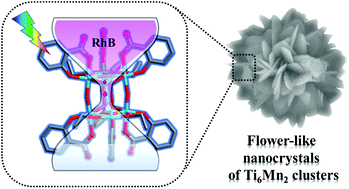Facile and scalable synthesis of Ti6Mn2 oxo-cluster nanocrystals with flower-like morphology and excellent photocatalytic properties†
Abstract
Three new phenylphosphonate (PhPO3) and salicylate (Sal) substituted heterometallic titanium-oxo clusters (ST-M), namely [Ti6Mn2O4(OEt)4(PhPO3)2(Sal)6(EtOH)2] (ST-Mn), [Ti6Zn2O4(OEt)4(PhPO3)2(Sal)6(EtOH)2(H2O)2] (ST-Zn) and [Ti6Tb2O4(OiPr)4(PhPO3)2(Sal)6Cl2(iPrOH)2]·iPrOH (ST-Tb), were synthesized. The most impressive structural feature of these compounds is the calixarene-type carboxylate endpoint in the Ti6-oxo core, which can readily capture metal ions with different radii and coordination geometries, for example, Mn2+, Zn2+ and Tb3+ ions in this case, to generate neutral mixed-metal Ti6M2-oxo clusters. Flower-like ST-Mn (denoted as FST-Mn) nanocrystals formed by nanosheets can be facilely obtained in gram-scale quantities from a simple solution reaction using Triton X-100 as a conditioning agent. The catalytic activity of these materials was evaluated by photocatalytic degradation of rhodamine B (RhB), among which FST-Mn showed the highest catalytic activity. Under visible light, 93.0% of RhB (50 ppm, 100 mL) was decomposed within 30 min catalyzed by FST-Mn without adding hydrogen peroxide, which is quite preeminent among Ti based catalysts. The catalytic decomposition efficiency under the same experimental conditions was 80.0% for ST-Mn, 24.6% for ST-Zn and 17.6% for ST-Tb. Investigation of the degradation mechanism showed that h+ and ·OH were the dominant active species in the decomposition of RhB. Moreover, the reusability and stability of FST-Mn were also verified.



 Please wait while we load your content...
Please wait while we load your content...